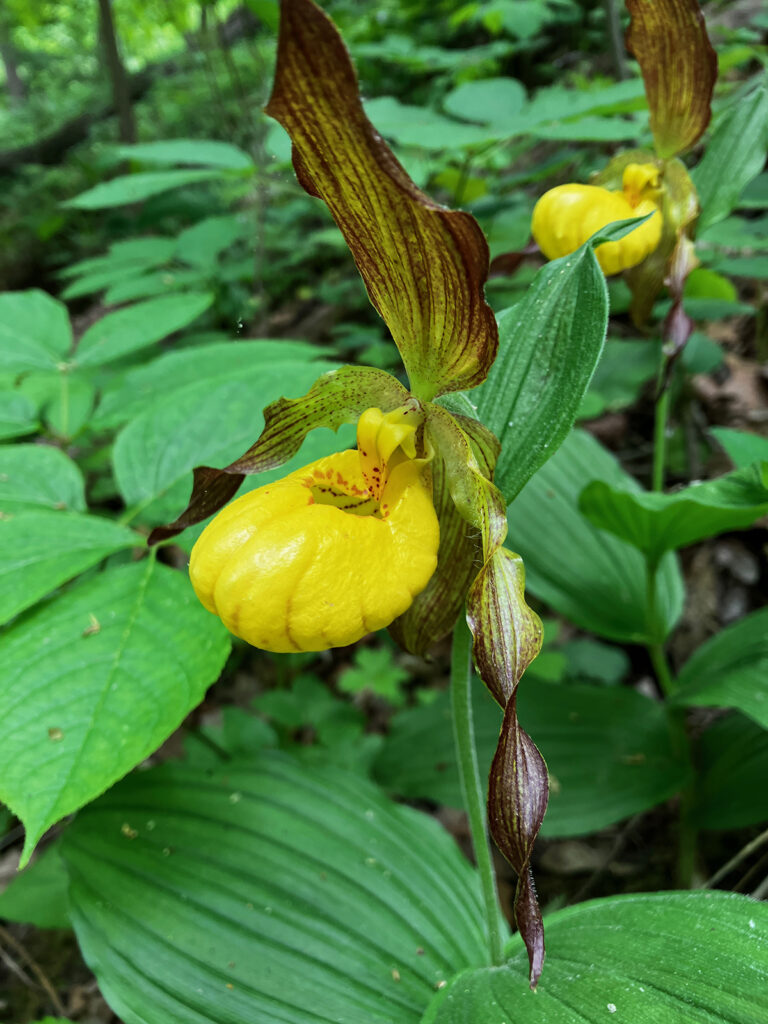There are those moments in life that really stick in your memory. For me, a lot of these experiences revolve around nature. Finding a native orchid in the wild is one of my ingrained memories. It involved being driven to a site blindfolded by a botanist who wanted to keep the location secret. It was a bit like Tolkien’s Lord of the Rings novel, where the Fellowship was led blindfolded into the forested elven realm of Lothlorien. My quest was to see a healthy population of Yellow Lady’s Slipper orchids (Cypripedium parviflorum). There, in a deep, rich, wooded ravine along the bluffs of the Illinois River was a display of beautiful golden slipper-shaped flowers. I might have even muttered “my precious” at the sight.
These flowers resemble a bright yellow moccasin with several twisted reddish laces that arc back from the main part of the flower. This plant was once much more common along the bluffs of the Illinois. Early pioneer writings talk of the ease in which great bouquets were gathered of this beautiful orchid. Another name for this plant is Whip-poor-will’s Shoe. Interestingly, this old and often forgotten name hints at the preferred habitat of this plant. Like the Whip-poor-will, this orchid does best in the open oak woods. The dappled sunlight through the newly leaved trees of mid-May, along with rich woodland soils — and ample moisture — sets the stage for this flower to prosper.

Yellow Lady’s Slipper orchids grow in a location in Peoria County where volunteers have been working to eradicate invasive Garlic Mustard, which threatens orchids.
PHOTO BY MIKE MILLER
Yellow Lady’s Slippers are pollinated by several species of medium sized bumble bees. These bees are enticed to enter the yellow slipper in search of nectar, where they first come into contact with the female parts of the flower. Like a funhouse tunnel, the bees are required to follow the inward folds of the flower and leave the slipper in a different direction than they came. When they leave, they encounter the male part of the flower, where gummy pollen is deposited on the bee. While this might sound backwards (gathering pollen after contacting the female portion of the plant), it is a very clever trick that ensures cross pollination. This way, the plant cannot pollinate itself. The bee must visit more than one flower to pollinate the plant … an effective method of enhancing genetic diversity.
Orchids are a very diverse group of plants. There are some 45 species of orchids found in Illinois. None of them are very common, and more than half of them are listed as endangered or threatened species. One reason they are uncommon is the strange way they propagate. The “seeds” of orchids are more like microscopic dust. They can spread on the wind for many miles, but their microscopic size has a major drawback. Unlike larger seeds, which are storehouses of energy, the microscopic seeds of orchids need assistance to grow. Orchid seeds must encounter a unique species of fungal mycorrhiza to form a symbiotic relationship for germination to occur. The fungus provides a network to enrich the seedling with water and nutrients, the orchid will provide the fungus with sugars derived from photosynthesis. This symbiotic relationship of orchid propagation is just beginning to be understood by ecologists. Many researchers are trying to identify just what species of fungi different orchids need to successfully reproduce. It turns out, it isn’t a simple relationship. Different species of orchids need different fungi. Few symbiotic relationships are simple, and the ability of identifying mycorrhizal fungi is a very complex genetic endeavor. One lab where this work is happening is at Illinois College in Jacksonville. A small college in the middle of corn country is attempting to understand the complexities of some of the earth’s most rare wildflowers.
Prior to the realization of the complex relationship of orchid to fungi, many orchids were destroyed by people transplanting them. This is one reason why my first orchid experience involved a blindfold. Botanists still are very cautious about sharing the location of orchids. Soil fungi can’t simply be transplanted along with an orchid. The transplanted orchid would survive for a short time, then whither into nothingness. An entire population of rare Showy Lady’s Slipper (Cypripedium reginae) growing in a small nature preserve in Woodford County were likely lost to people attempting to transplant them.
Other factors are also leading to decline in orchid populations. Deer love eating them. Today’s populations tend to be found precariously perched in areas where deer have difficulty accessing. Another factor is the increasing impact of invasive species. Garlic Mustard, Bush Honeysuckle, and a host of other exotic species have become more prevalent in our natural areas. These plants can alter the soil composition and reduce the diversity of fungi thriving in the once-rich soil.
The deck seems stacked against the survival of orchids in the long term. That stand of orchids I first visited 40 years ago is now gone, replaced by a dense stand of Garlic Mustard. However, in woodlands where caring people have removed invasive species, and brought health back to the landscape, new populations emerge. Human beings can be good stewards of the land. As Gandalf explained to a forlorn Frodo, who lamented about not wanting to live in a world experiencing such strife, “And so do all who live to see such times. But that is not for them to decide. All we have to decide is what to do with the time that is given us.”


Recent Comments